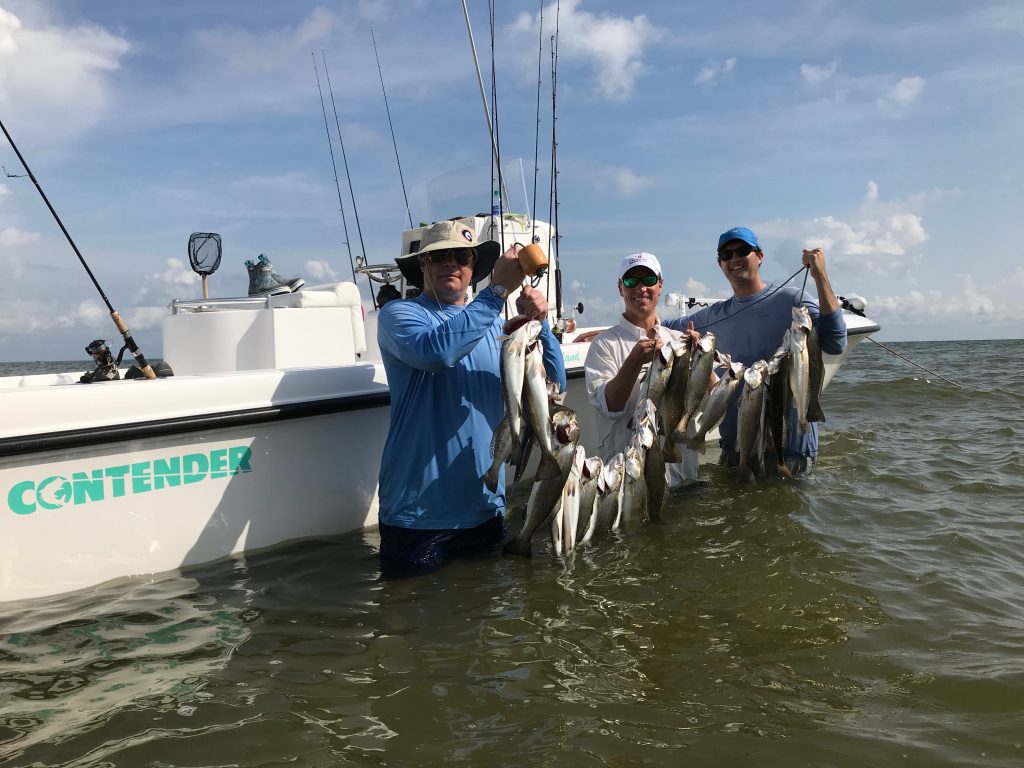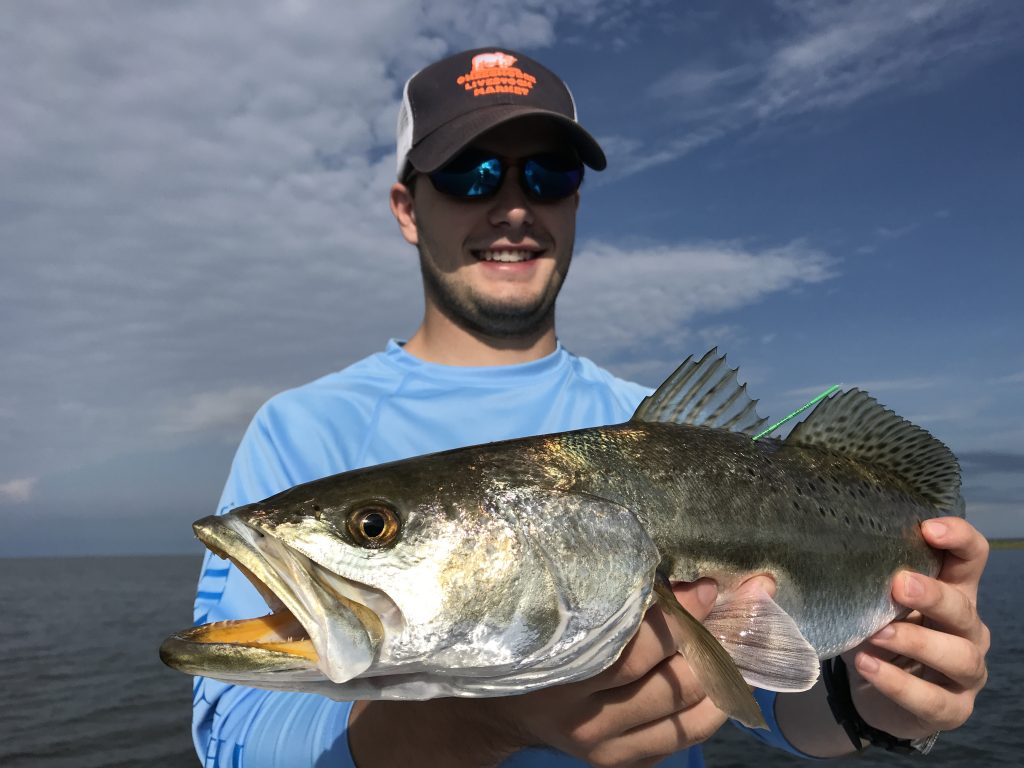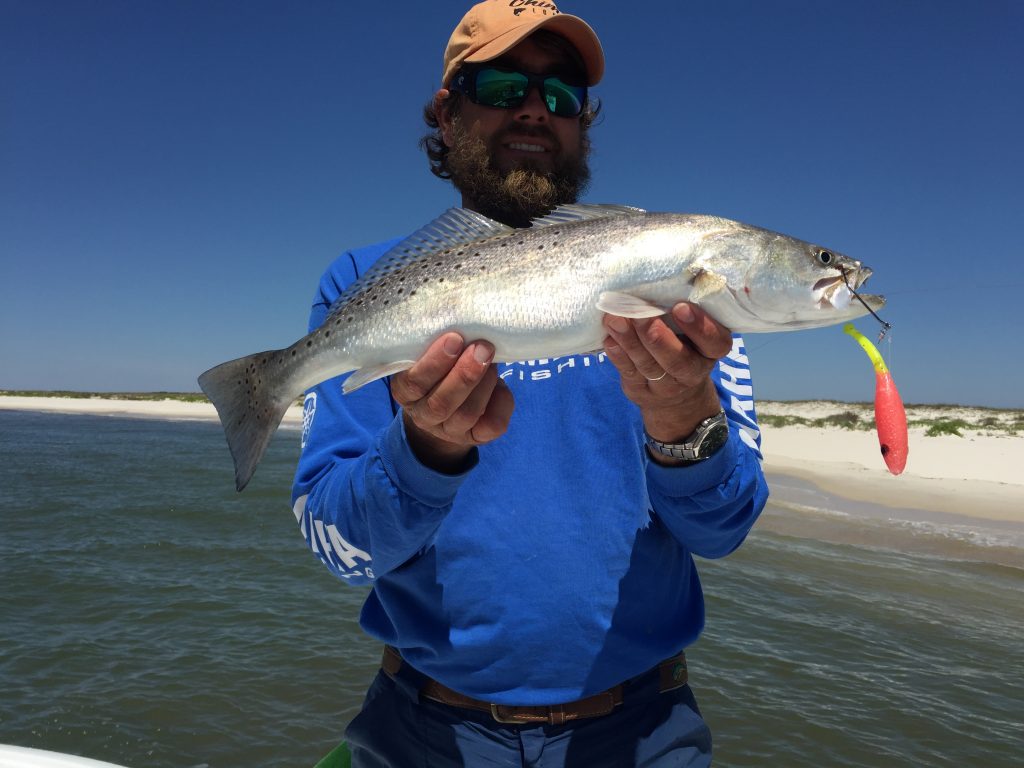Saltwater Wade Fishing Tips For Catching Speckled Trout
As someone who gets to fish almost every day for a living, when the fish show up on the Gulf beach I just about can’t sleep at night and that’s saying a lot considering my days start at three to four o’clock in the morning most days during the summer months. The really fun part about it is how aggressive the fish can be when you’re saltwater wade fishing. Surf fishing for speckled trout on Gulf beaches has produced some of the most aggressive schools of speckled trout I have ever encountered.
Catching speckled trout in the surf can be easy, considering they will eat almost any type of live bait and an array of different lures. I love fishing both baits but I’m fond of chunking lures at them. Armed with the proper saltwater wade fishing gear and tactics on how to catch speckled trout in the surf, anglers will be reeling them in with ease.
Speckled trout are littered all along the Gulf Coast from the 10,000 Islands all the way to the southern tip of Texas. Most of what I’m talking about in this article relates to many different places all along the Northern Gulf Coast. Many years specks show up in about May and will reside on the beaches until about September when the first hints of fall weather start. The beaches will warm up faster than the rest of the surrounding waters but I always start to see them “come to life” for surf fishing speckled trout when the water temperatures start to reach 68-70 degrees.
Wade Fishing Tactics
“Come to life” is a term that I live by when I first start to find fish on the beaches. Finding life in general is a key to success on the Gulf beach and that means looking for schools of bait fish on your bottom machine when cruising, finding birds working in the surf, seeing porpoises feeding and looking for mullet jumping.
Most years when approaching late spring and early summer I jump at the opportunity to get on the beaches well before the fish show up. I like to run at a slower speed and really take note of the “lay of the land” and make marks on my GPS to come back later and fish in the future.

Anglers don’t have to go into deep water to catch a nice haul of speckled trout.
Utilizing your GPS does a couple things for you. I like to start my morning very early and finding a place I am not familiar with in the dark can have its challenges and that recorded information makes things easier. It also provides me several location options to fish if other fishermen are in any of the places I marked.
I look for points along the beach where there are a series of sand bars with deeper water adjacent. Anytime I find deep water, four to eight feet, next to the beach or next to a sandbar I make a note. On higher water the fish will sometimes be on top of the bars and in lower water I look for them in the deeper water next to a shallow bar. Anytime you can find structure on the beach like wrecks, rocks, bulkheads, pilings and clay/mud lumps are great places to start as well. The main ingredient for me though is always finding big schools of mullet. It doesn’t have to be finger mullet sized bait either, I like to see schools of big mullet either jumping or smoking on the surface.
Saltwater Wading Gear
When I think about how to catch speckled trout in the surf with live bait, I really favor croakers. They are usually very easy to come by at a few bait shops, pulling a small shrimp net, catching them on hook and line or cast netting them. Live Menhaden are very hard to keep alive but also work very well in the surf. For fishing live croakers, I like to use a 7 ½ foot medium power fast to moderate fast action rod and we fish a free-lined setup with no weight. I prefer a casting rod with 12 lb. monofilament line with a 4-6-foot section of 15-20lb. fluorocarbon leader with a 1/0 to 2/0 Owner SSW live bait hook.

Looking for structure on the beach is a great place to start your wade fishing trip.
I like the casting rig because I can easily free spool the reel and let some line out to allow the fish to swallow the bait. When I get a bite, I usually count four to six seconds before setting the hook. We also use spinning setups with 7 ½ foot rods spooled with 15-20 lb. braided line with a four-foot section of fluorocarbon leader attached with an improved albright knot.
To fish this saltwater wade fishing gear, I make long casts into or around the deeper sides of sandbars. I leave enough slack “belly” in my line to give the fish a chance to swallow the bait before I set the hook but, at the same time, keep enough tension on the line so I can slowly work the retrieve back and know when I get a bite. A typical cast and retrieve is about a one to three minute process.
Sometimes, the whole bait will pull out of the fish’s mouth and, if you can be patient enough and pause, most times you will get another bite quickly. While I don’t know if these bites are from the same fish or other fish competitively feeding in the school, it frequently happens.
In terms of wade fishing baiting, I have found that hooking the bait through the top lip/nose of the croaker is the best route. There is a fine line between not hooking it deep enough or hooking it too deep and that will come with experience over time. It is important to note that if you aren’t getting bites relatively quickly you need to be moving. The beach bite is not really one to turn on and off at certain times. If they are chewing you will know it pretty quickly so always be on the move until you get a bite.
On a lot of my charters I will tell my clients to make sure to keep up with me. Unfortunately, I have found myself 200 yards down the beach experiencing a good bite and hollering for them to come join me for the fun.
I said earlier that I prefer to fish lures when catching speckled trout in the surf due to the amount of water that can be covered in a short amount of time. Sometimes they are only on the live bait and not lures and other times you can catch them better on lures. If I am not getting bites, I am constantly moving down the beach to find the next school of fish.
My morning saltwater wade fishing gear is always a topwater lure, to start. If you get lucky and have very calm, quiet and smooth conditions I prefer a smaller topwater like the Rapala Skitter-V. When I have a little more wave action and wind, I throw larger topwaters like my favorite, the Heddon Super Spook.
When it comes to color, pink always seems to be a great color but a lot of days I throw color out the window because it seems like it doesn’t matter. I like to try and match the color to the water conditions. If it’s a clear day with clean water I go with bright colors and if it’s cloudy or off-color water I go a little darker. Topwater is usually an early morning and low light tactic but I have seen many days when they will chew them up all day. You have to throw it to know what the fish are in the mood for that day.

The right speckled trout rig for wade fishing will have you landing specks more often.
My all-time favorite piece of saltwater wade fishing gear and just favorite lure to throw for speckled trout anytime of the year is The Slick Lure. I like this soft plastic jerk bait because of the unbelievable natural action it has in the water and the translucent colors that they carry. I only fish this lure on the Owner Beast 4/0 in the 1/8 ounce weighted hook. The 4/0 hook only comes two ways which is unweighted and weighted 1/8 ounce. I only fish the weighted version year-round. My favorite colors are pink/chartreuse, pearl/chartreuse, goblin, bayou blues, cool beans, and mad mullet.
With the Slick Lure, I use a medium power fast to extra fast casting rod in about 7-7 ½ ft with a low-profile casting reel spooled with 30 lb. braided line tipped with a 20 lb. fluorocarbon leader. It is critical when attaching a lure to your line that you use a loop knot. My “go to” loop knot is the Lefty Kreh Loop Knot. It’s very strong and easy to tie, but does need to be retied a few times throughout the day to avoid failure from the light teeth that speckled trout have.
I try to make long casts to cover as much water as possible while adding two aggressive twitches with a short pause in-between.
There is definitely an art to mastering the Slick but once you figure it out it’s truly a game changer. When it comes to setting the hook, I like to come out of my shoes on my hook set. This lure is a large profile with a lot of plastic and you have to overcome that with a big hook set. Once hooked and on the line, you can play the fish back to you with light pressure because of the wide gap in the hook.
While I really like to use Fishbites for redfish and flounder I have found that they also work well for speckled trout. In the Fight Club series, I’ve found that the Brawler five-inch jerkbait in the haymaker color is a winner. I also have had success with the four-inch Butt Kicker paddle tail also in the haymaker color. These are great for those occasions where you may be battling some dirty water conditions. The Haymaker color is a good dirty water color but also the added scent will also help to overcome tough water conditions. One of my other go to colors in the Counter Punch which is a Chartreuse color.
As far as rigging goes, I use from a 1/8 to ¼ ounce jig with a Hogie jig head for either the Brawler or the Butt Kicker and work it a little bit fast on the beach twitching it along pretty quickly. I also like rigging it with a weighted Fight Club weighted swim bait hook for a more subtle approach in calm conditions. I will put those on a 20-pound fluorocarbon leader attached to 15 to 30 pound braid and sometimes a lighter leader in clear water conditions.
You could tie them under a popping cork if you were fishing in dirtier water and for that setup, I use a 2 ½ foot section of leader under the cork attached to a Fight Club weedless hook worked with a 7 ½ foot medium light rod with an extra fast tip and a 2,500-3,000-size spinning reel. This is a great all around go to setup in many different conditions and areas around bays and estuaries.
As far as surf fishing goes for me I do not have a lot of opportunities to sight-cast Trout on the beaches but many times redfish make themselves available. The Fight Club series in many different patterns and colors are a great bait selection to take advantage of Redfish on the beach. I like to use the lightest weight that the conditions will allow to avoid making a big slash with the lure and spooking the fish. When casting I like to lead the fish or school of fish by quite a margin and reel the lure back quickly to get in front of the fish. Once you feel your lure is in front of the fish, slow down your retrieve with small twitches to spark a bite.
When Wade Fishing Fails
When I think about how to catch speckled trout in the surf, I always prefer to be in the water if possible but sometimes that can be tricky due to the sea state. Wade fishing away from the boat allows you to be stealthy and a bit sneaky approaching fish or fishy spots. A boat in the water makes a lot of noise and causes water displacement that the fish can feel, especially on the calmer days. When wade fishing you want to park your boat at a minimum of 100 plus yards away from your fishing spot. Make sure you use a good heavy anchor and anchor the boat off the beach a little. It takes no time for the waves or a wind change to blow the boat up on the beach, which leads to calling a buddy to pull you off, not to mention if you have a storm blow up on you quickly.
Some saltwater wade fishing gear you want to have is a good belt with a set of pliers, tackle box, extra leader material, braid cutter like the Boomerang tool, a stringer, measuring device (or mark on your rod for minimum and maximum size fish), a small landing net and a good pair of wading shoes. I never get in the water to wade fish without a good pair of wading shoes on. There are too many unknown obstructions on the bottom to worry about and it’s easy to find something to wear on your feet in the water.

The ability to effectively anchor your boat is necessary to keep you on the fish.
When surf fishing for speckled trout from the boat, I like to always be on my trolling motor if the conditions are calm enough to do so. Having a Power Pole or anchor feature on your trolling motor is a “must have” to really be effective in setting up on a school of fish and, at the same time, be mindful, when using either, of wave action, which could push you into shallower water. If you get in too shallow of water on top of a sand bar you can break the motor shaft or torque your Power Pole to the point of failure. I have experienced both of these and it doesn’t make for a fun day.
When it’s too rough to use a trolling motor or Power Pole in the surf I break out the anchor. I know this may seem foreign to some but an anchor is a very important part of my equipment on board my vessel. I try to setup the boat to where I can cast on the edges of bars and also into the trough next to the bar.
Final Thoughts On Wade Fishing
In closing I want to reiterate that when surf fishing for speckled trout, you really need to stay on the move until you get a bite and then slow down. When they quit biting, you need to start moving again until you hit on something else.
I also always preach long casting when saltwater wade fishing and in order to accomplish that and have a great fishing experience, an angler has to have a quality rod matched with a quality reel spooled with quality line and know how to use them. The more water you can cover in the shortest amount of time equates to more successful trips out on the water…and more fun.
Full Disclosure: This post may include affiliate links. There’s no extra charge to our readers for using these.
